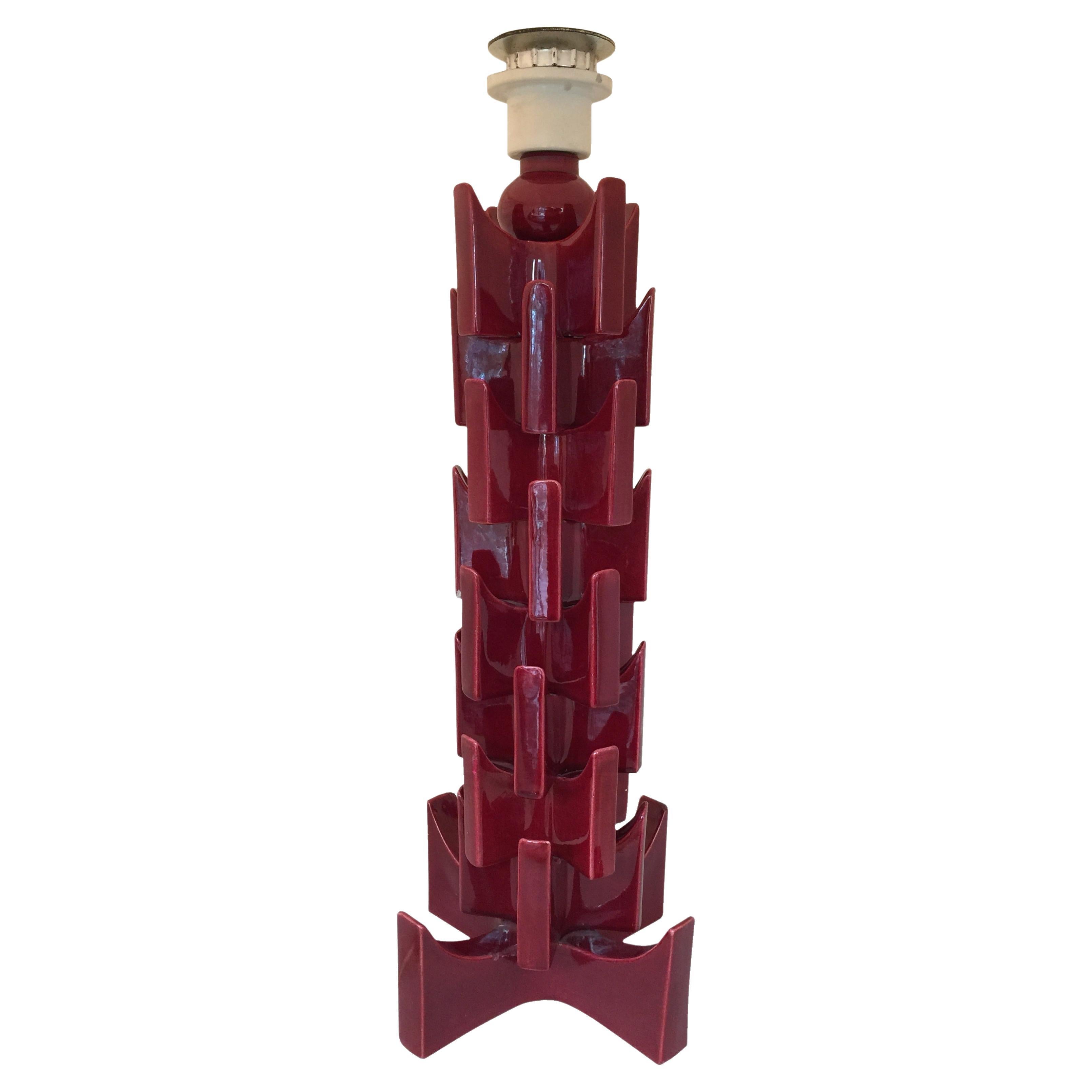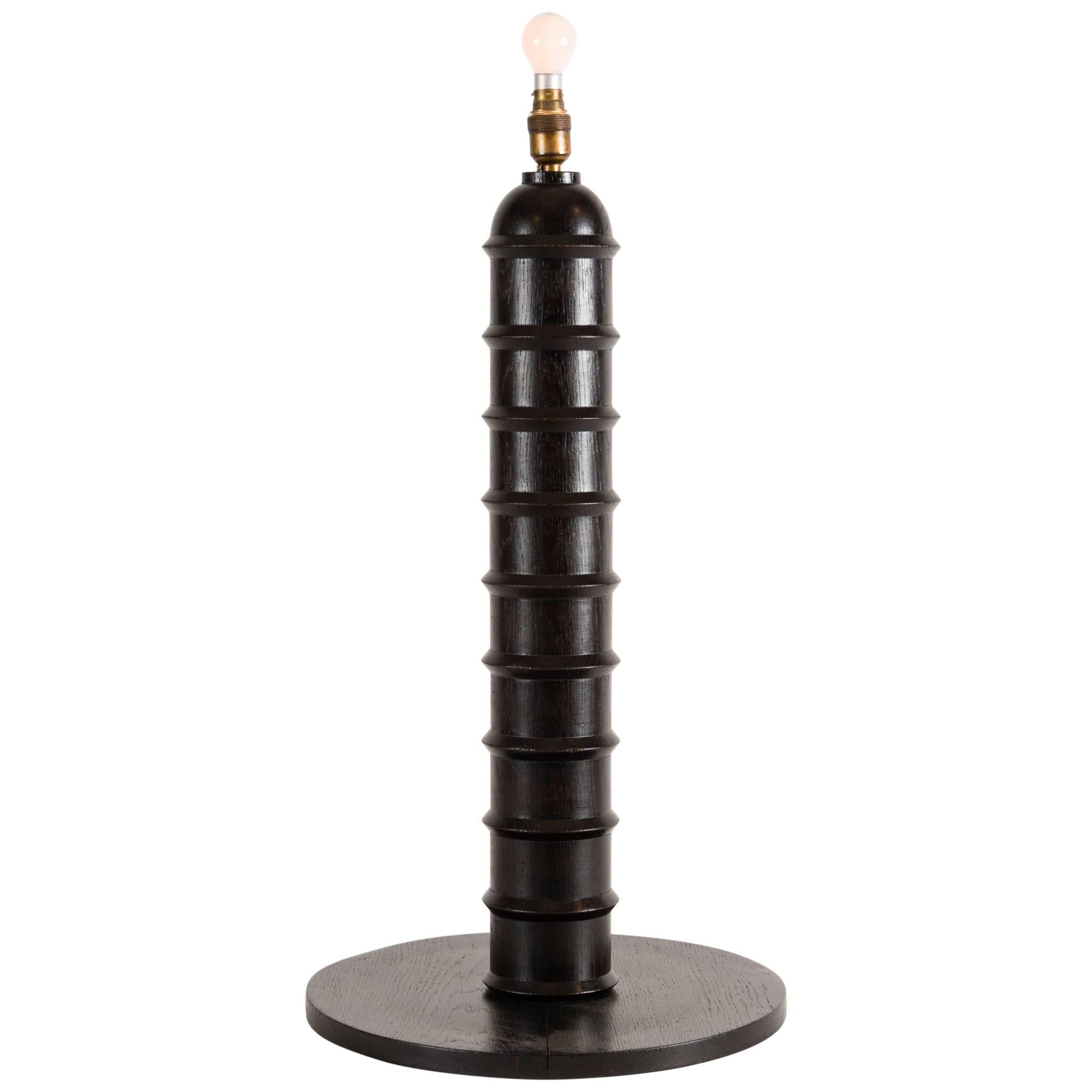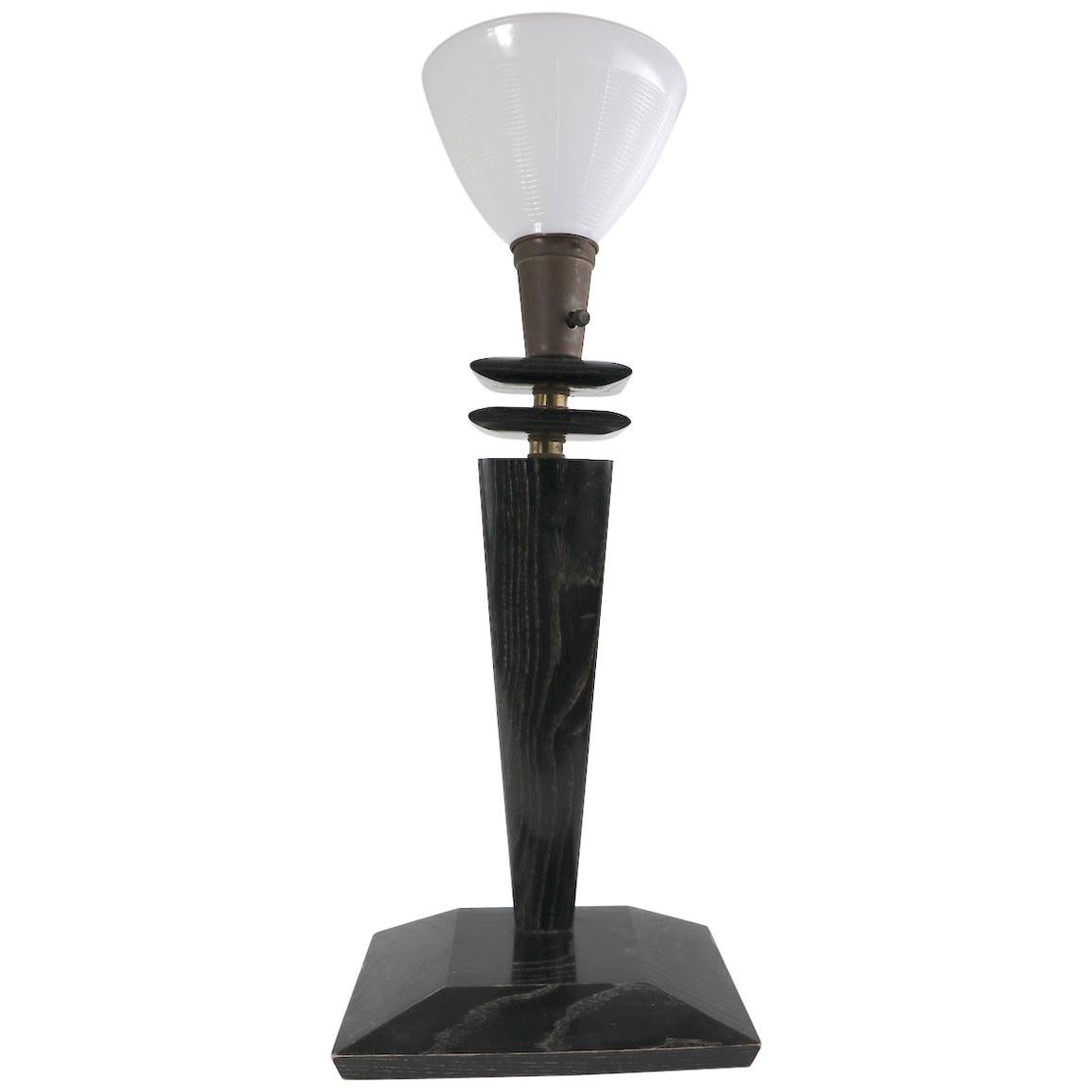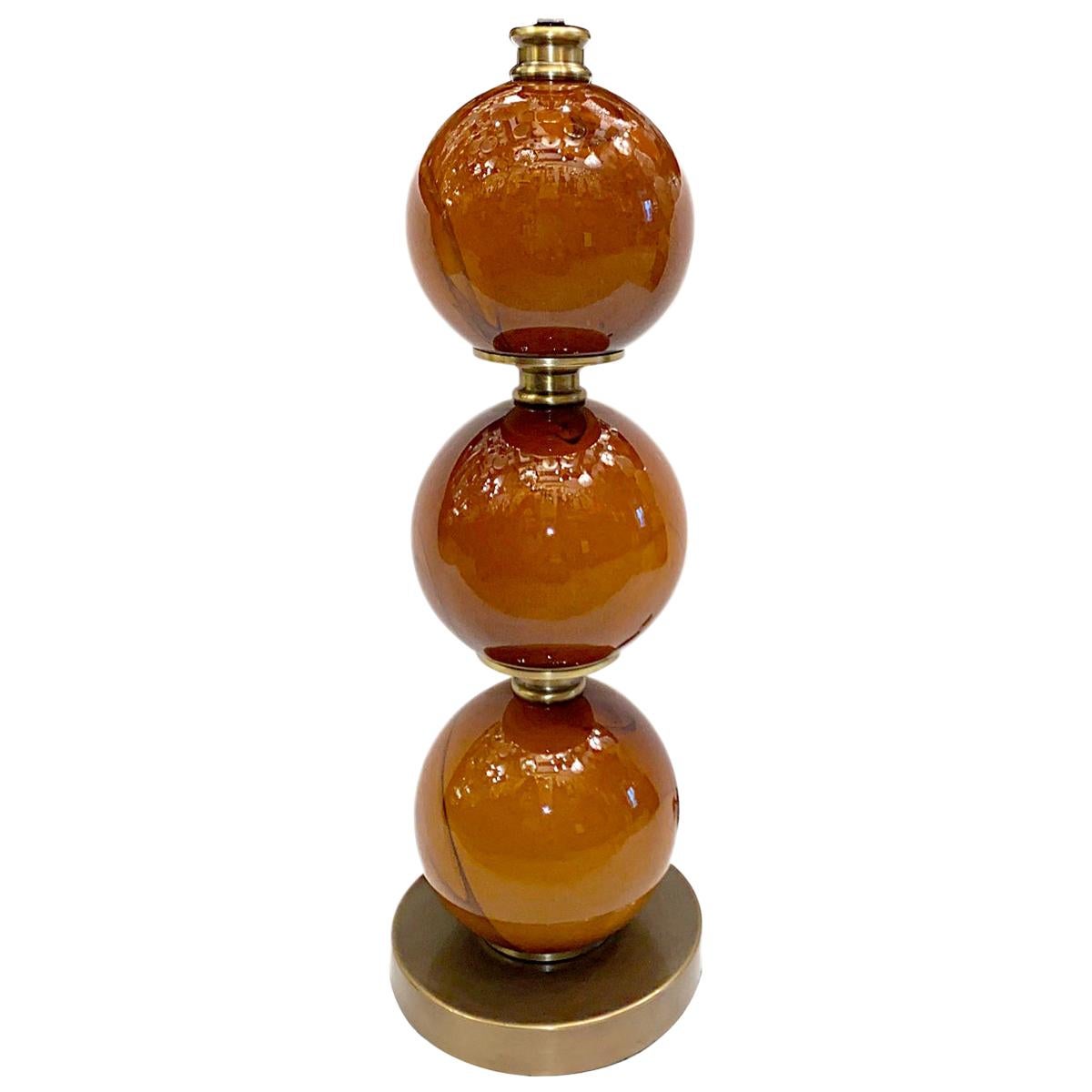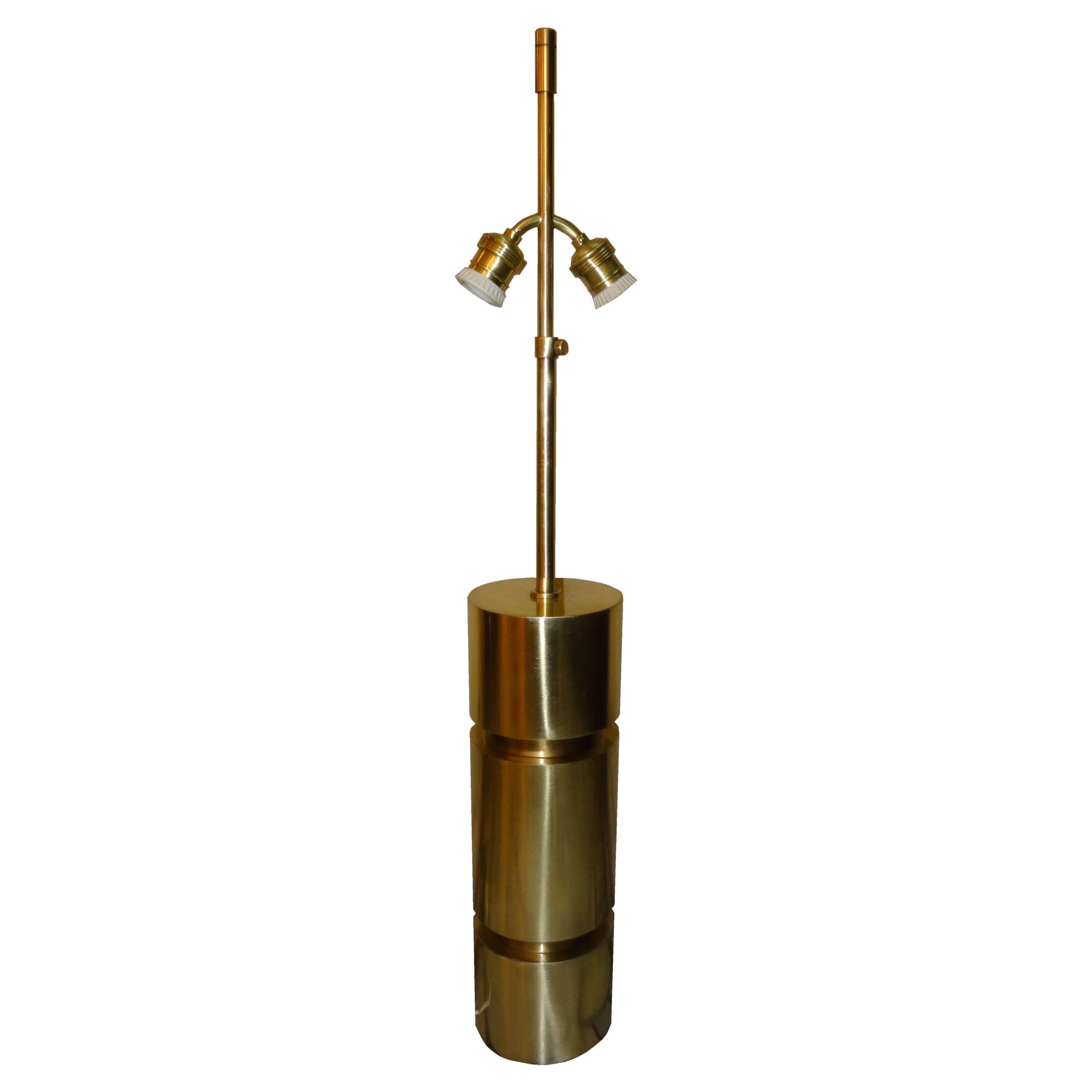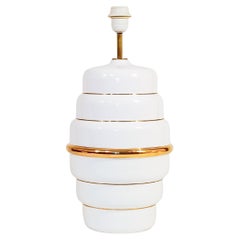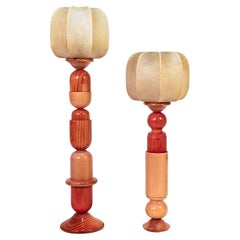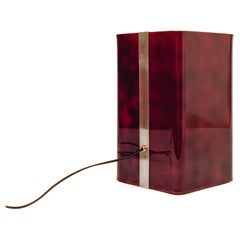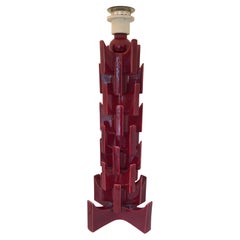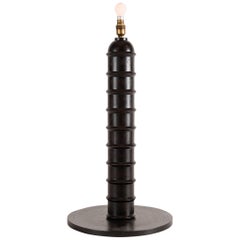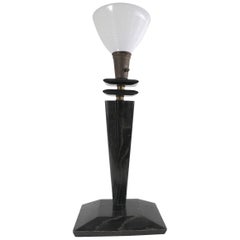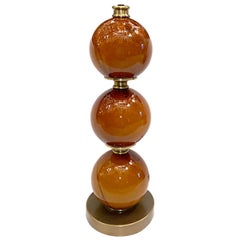Items Similar to Charles Dudouyt style. Sculptural cubist table lamp, France, 1940s
Want more images or videos?
Request additional images or videos from the seller
1 of 14
Charles Dudouyt style. Sculptural cubist table lamp, France, 1940s
$1,660.11
£1,234.18
€1,400
CA$2,300.62
A$2,564.74
CHF 1,337.62
MX$31,013.71
NOK 16,814.54
SEK 15,909.91
DKK 10,658.56
About the Item
Sculptural cubist style table lamp in the style of Charles Dudouyt's designs and creations, France, 1940s. Formed by several beech wood spheres joined together by an inner brass stem. Brass details.
For an E27 bulb. Renewed electrical installation, original lamp holder. The dials at the base have been screwed back together, without affecting the aesthetics of the piece. Lampshade not included. The measurements are without the lampshade.
- Similar to:Charles Dudouyt (Designer)
- Dimensions:Height: 17.72 in (45 cm)Diameter: 9.45 in (24 cm)
- Power Source:Plug-in
- Voltage:110-150v,220-240v
- Lampshade:Not Included
- Style:Art Deco (In the Style Of)
- Materials and Techniques:
- Place of Origin:
- Period:
- Date of Manufacture:Circa 1945
- Condition:Refinished. Rewired: Renewed electrical installation, original lamp holder. The dials at the base have been screwed back together, without affecting the aesthetics of the piece. Lampshade not included. The measurements are without the lampshade. Wear consistent with age and use.
- Seller Location:SANT ADRIÀ DE BESÒS, ES
- Reference Number:Seller: IS11991stDibs: LU10500245824962
About the Seller
New to 1stDibs
Joined in the past six months.
5.0
Gold Seller
Premium sellers maintaining a 4.3+ rating and 24-hour response times
1stDibs seller since 2025
10 sales on 1stDibs
Typical response time: <1 hour
- ShippingRetrieving quote...Shipping from: SANT ADRIÀ DE BESÒS, Spain
- Return Policy
Authenticity Guarantee
In the unlikely event there’s an issue with an item’s authenticity, contact us within 1 year for a full refund. DetailsMoney-Back Guarantee
If your item is not as described, is damaged in transit, or does not arrive, contact us within 7 days for a full refund. Details24-Hour Cancellation
You have a 24-hour grace period in which to reconsider your purchase, with no questions asked.Vetted Professional Sellers
Our world-class sellers must adhere to strict standards for service and quality, maintaining the integrity of our listings.Price-Match Guarantee
If you find that a seller listed the same item for a lower price elsewhere, we’ll match it.Trusted Global Delivery
Our best-in-class carrier network provides specialized shipping options worldwide, including custom delivery.More From This Seller
View AllPost-Modern ceramic table lamp, Italy, 1980s
Located in SANT ADRIÀ DE BESÒS, ES
Cubist and Post-Modern style ceramic table lamp, Italy, 1980s. It has the shape of a tibor or white glazed ceramic vase with golden hand-painted trims. The structure of the top is ma...
Category
Vintage 1980s Italian Post-Modern Table Lamps
Materials
Brass
Post-Modern hand-crafted Cocoon table lamps, Italy, 70s
By Flos, Achille Castiglioni, Tobia Scarpa
Located in SANT ADRIÀ DE BESÒS, ES
Pair of sculptural hand-crafted cocoon table lamps, Italy, 1970s. Formed by several varnished pine wood elements of different shapes and sizes, creating two curious columns of a cert...
Category
Vintage 1970s Italian Post-Modern Table Lamps
Materials
Resin, Wood, Pine
Harvey Guzzini. Tortoiseshell-like acrylic table lamp, Italy, 1970s
By Guzzini, Harvey Guzzini
Located in SANT ADRIÀ DE BESÒS, ES
Post-Modern style table lamp in the style of Guzzini creations, Italy, 1970s. This table or floor lamp has the shape of a prism with rounded edges and made entirely of methacrylate o...
Category
Vintage 1970s Italian Post-Modern Table Lamps
Materials
Brass, Steel, Chrome
Toni Zuccheri. Space Age Murano table lamp, Italy, 1970s
By Toni Zuccheri
Located in SANT ADRIÀ DE BESÒS, ES
Italian Spaceage table lamp in the style of Toni Zuccheri's artistic creations. Murano glass tulip with organic shapes combining the smoky tone with transparent and red. Chrome metal...
Category
Vintage 1970s Italian Space Age Table Lamps
Materials
Metal, Chrome
Toni Zuccheri. Space Age style murano glass table lamp, Italy, 1970s
By Toni Zuccheri
Located in SANT ADRIÀ DE BESÒS, ES
Italian brutalist and Space Age style table lamp by Toni Zuccheri, 1970s. Golden and silver chromed steel metal base and a spherical upper diffuser made of transparent Murano glass c...
Category
Vintage 1970s Italian Space Age Table Lamps
Materials
Steel, Chrome
Bauhaus style big table lamp by André Ricard for Metalarte, Spain, 1970s
By André Ricard, Metalarte
Located in SANT ADRIÀ DE BESÒS, ES
Important table lamp designed by André Ricard in 1969, and produced and manufactured by Metalarte in the 60s and 70s. Chrome steel structure and white opal shade. Very much in Art De...
Category
Vintage 1970s Spanish Bauhaus Table Lamps
Materials
Metal, Chrome
You May Also Like
Art Deco Table Lamp, Denmark, 1920 in Ceramic
Located in Ciudad Autónoma Buenos Aires, C
Table lamp Art deco
Materia: Ceramic
Style: Art Deco
To take care of your property and the lives of our customers, the new wiring has been done.
If you want to live in the golden ye...
Category
Vintage 1920s Danish Art Deco Table Lamps
Materials
Ceramic
Possibly by Charles Dudouyt, Table Lamp Base, Blackened Wood, France, circa 1930
By Charles Dudouyt
Located in New York, NY
This lamp in blackened wood by Charles Dudouyt possesses a round, flat base and a cylindrical, towering body accented with well spaced horizontal bands.
Category
Early 20th Century French Art Deco Table Lamps
Materials
Wood
Cerused Table Lamp after Heifetz
By James Mont, Yasha Heifetz
Located in New York, NY
Stylish midcentury table lamp of cerused oak, with milk glass diffuser, vintage burlap shade not included. Lamp design influenced by Heifetz, and Mont. ...
Category
Mid-20th Century American Mid-Century Modern Table Lamps
Materials
Oak
Single Midcentury French Art Glass Lamp
Located in New York, NY
A single circa 1960's French art glass table lamp.
Measurements:
Height of body 20"
Height to shade rest: 30.5" (adjustable)
Diameter of base: 7" (widest point)
Category
Vintage 1960s French Mid-Century Modern Table Lamps
Materials
Blown Glass, Art Glass
French Mid-Century Modern Ceramic Table Lamp in the Manner of George Jouve
By Georges Jouve
Located in New York, NY
A French midcentury organic form table lamp with an exotic sculptural form. This piece reads differently from every angle due to its combination of ...
Category
Vintage 1950s French Mid-Century Modern Table Lamps
Materials
Ceramic
Table Lamp, 1930, Material: Bronze, France, Attributed to Jean-Charles Moreau
By Jean-Charles Moreux
Located in Ciudad Autónoma Buenos Aires, C
Table lamp
Materia: bronze and glass
Country: France
To take care of your property and the lives of our customers, the new wiring has been done.
We have specialized in the sale of Art Deco and Art Nouveau and Vintage styles since 1982. If you have any questions we are at your disposal.
Pushing the button that reads 'View All From Seller'. And you can see more objects to the style for sale.
Why are there so many antiques in Argentina?
In the 1880 – 1940 there was a grate wave of immigration encouraged by the periods of war that were taking place.
1st World War took place between 1914 and 1918
2nd World War took place between 1939 and 1945
The immigrants options were New York or Buenos Aires. Tickets were cheap and in Buenos Aires they were welcomed with open arms, as it was a country where everything was still to be done.
Argentina was the country of new opportunities, labour was needed and religious freedom was assured, in many cases the of the family travel first until they were settled and then the rest of the family members join them.
In the immigrant museum “Ellis Island Immigrant Building” in New York you can se the promotional posters of the boats that would take them to a new life.
Between the years 1895 and 1896, Argentina had the highest DGP (gross domestic product) per capita in the world according to the Maddison Historical Statistics index, this situation arose due to the large amount of food being exported to European countries, which were at war.
The Argentinean ships left the port of Buenos Aires with food, but they returned with furniture, clothes and construction elements, (it´s common to see this the old buildings of the historic neighbourhood of San Telmo, the beams with the inscription “Made in England)”, as well as many markets that were built in Buenos Aires, such us the San Telmo Market, whose structure was brought by ship and afterwards assembled in 900 Defensa Street.
With the great influence of European immigrants living in the country, the children of the upper classes travelled to study in France, resulting in the inauguration of “La Maison Argentinienne”, on 27th of June 1928, in the international city of Paris, which hosted many Argentinians that were studying in Frace.
It´s the fourth house to be built after France, Canada and Belgium, being the first Spanish-speaking one. Still in place today (17 Bd Jourdan, 75014, Paris, France). Many of the children of these wealthy families who attended international art exhibitions, museums and art courses abroad, took a keen interest in the European style. This is why Buenos Aires was at the time referred as “The Paris of South America”.
Between the years 1890 and 1920 more than a hundred Palaces were built on Alvear Avenue the most exclusive avenue in Buenos Aires. Today some of these palaces have been transformed into museums, hotels and embassies.
In the year 1936, the Kavanagh building was inaugurated, it was the tallest reinforced concrete building in South America.
During 1994 the American Society of Civil Engineers distinguished it as an “international engineering milestone”, and it´s now considered a World Heritage of Modern Architecture.
At the time was common to hire foreign architects such as Le Corbusier, who visited Buenos Aires/Argentina in 1929 and in 1948 he drew up the blueprints for a house built in La Plata City (which was declared a World Heritage Site).
In 1947, the Hungarian architect Marcelo Breuer designed “Parador Ariston” in the seaside city of Mar del Plata. After an Argentinean student at Harvard University convinced him to come to Argentina. He worked on an urban development project in the Casa Amarilla, area of La Boca.
The Ukrainian architect, Vladimiro Acosta, arrives in Argentina in 1928 and worked as an architect until que moved to Brazil.
Antonio Bonet, a Spanish architect who worked with Le Corbusier in Paris, arrives in Argentina in 1937, where he carried out several architectural works and in 1938 designs the well-known BFK chair.
Andres Kálnay, of Hungarian origin, made around 120 architectural masterpieces, among which the former Munich brewery stands out, he even made the furniture’s design.
The German architect, Walter Gropius, director of the Bauhaus, lived in Argentina, where he wrote articles for “Sur” magazine and founded in Buenos Aires, an architectural firm with Franz Möller, who was also an architect, where he built two houses.
At the same time several famous designers decided to immigrate to Argentina, among them we can find the well-known French designer, Jean-Michel Frank, who arrived in the country in 1940 and also worked for the Rockefeller family.
Special pieces were made, which were sold exclusively in the country, such as the well-known German company “WMF”, who sold their products by catalogue, which were chosen by the ladies of high society in the list of wedding gifts, as well as the pieces designed by Christofle.
The Swiss sculptor Alberto Giacometti, made special pieces for Argentinean mansions.
In 1904 the first Jansen branch outside Paris was established in Buenos Aires, as the Argentinean clientele demanded a large amount of furniture, from the end of the 19th century to the mid-20th century.
In 1970, the brand Rigolleau Argentina made pieces authorised by Lalique.
The brands Maple and Thompson also set up shop in the country.
The French plastic artist, Marcel Duchamp moved to Argentina in 1918-1919.
Glass signed Gallé, Charder, Leverre, Schneider, Muller and other French firms. They were bought in flower shops and were given to ladies with beautiful floral arrangements.
Some furniture manufacturers travelled to international fairs and bough the patterns to produce the furniture in Argentina, such as the furniture firm Englander and Bonta, who bought the patterns ins Italy.
It is worth mentioning that in Argentina we have the largest community of Italians outside of Italy, as it is estimated that 70 percent of the inhabitants have at least one Italian descendant, followed by Spanish immigrants.
The most Important furniture stores in Argentina:
Comte is founded in 1934 (under the direct management of Jean Michel Frank in 1940).
Nordiska (Swedish company established in 1934).
Churba in 1960, a company that brought foreign designers to present their furniture in the country:
Denmark: (Arne Jacobsen, Finn Juhl, Bender Madsen, Ejner Larsen, Poul Kjaerholm, Hans Wegner)
Sweden: (Hans Agne Jakobsson, Gustavsberg)
United States: (Herman Miller)
Finland: (Lisa Johansson, Folke Arstrom, Tapio Wirkkala, Alvar Aalto, Timo Sarpaneva)
Swedish Factory: (Orrefors)
Italy: (Littala, Vico Magistretti, Emma Gismondi, Gae Aulenti, Angelo Mangiarotti, Elio Martinelli, Gianna Celada, Angelo Mangiarotti, Mario Bellini, Carlo Scarpa)
Finland: (Olivia Toikka)
Plata Lappas (Lappas Silver): a goldsmith shop founded in 1887 in Argentina by Alcibiades Lappas of Greek origin.
In 2019, in Argentina took place “the Art Deco world congress”, in which we participated as hosts invited by Geo Darder, founder of the Copperbridge – Foundation, in which prominent people from all over the world attended to learn about Art Deco in Argentina.
Argentina currently has more than 100 Art Deco buildings and another 90 Art Nouveau buildings throughout the city of Buenos Aires.
Argentina is a country that has not been involved in many wars, which is why it has been a refuge for works of art and antiques from different periods of time, unlike European countries. That is way many collectors, museums and antique dealers from all over the world visit it, you should not miss the opportunity to visit this great country.
Laura Guevara Kjuder, architect.
JEAN-CHARLES MOREUX
(1889-1956)
French architect and designer Jean-Charles Moreux was born in 1889 at the Chateau de Joncy in Saone-et-Loire. He studied at l’Ecole de Beaux-Arts in Paris (1914-22) where he spent the period during World War I working on the preservation of works of art. While attending l’Ecole he became friends with the architect Jean Lurcat and his brothers, Andre and Paul Vera.
In 1924 he exhibited his first pieces of furniture at the Salon d’Automne. He had a preference for poetic living spaces and felt that people deserved better than Corbusier’s “machines for living in”. He was anxious to introduce aspects of the marvelous into architecture and living spaces. His creations drew upon the classical, baroque, and rococo styles.
Moreux’s well-known clients included the Baron Robert de Rothschild and Bolette Natanson...
Category
Vintage 1930s French Art Deco Table Lamps
Materials
Bronze
More Ways To Browse
Haruo Momoki
Horsehead Lamp
Icee Vintage Light
John Van Zwienen
Joseph Brumberg Sundern
Luis Laplace
Nickey Kehoe Lighting
Nissen Lamps
Palmiers Jansen
Salgado Saucier
Scaglione Table
Stiffel 3 Ball Brass Lamps
Tak Japan
Uppsala Armatur
Hong Kong Porcelain Lamp
Japanese Bronze Lamps 1920s
Jean Dunand Lamp
Hertz Ballin
